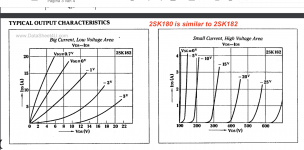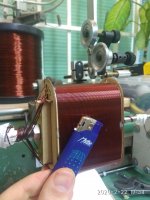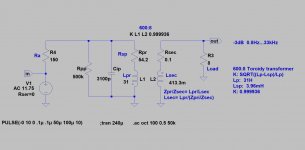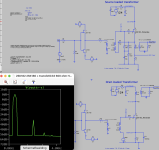I posted in "Transformer distortion (THD)" which is called highjacking . . . 😢 Thanks for the responses [maybe a separate thread would have been better ..]
But You are right, the high inductance means very good low end.
Both transformers are € 230 - 240 incl shipping
Of course, because it is just for my life long experimenting, lower is better 🙂
I have a rather linear output of the amplifying device. 135 Vb is doable, so low side. 600/8 = enough for the room with 150Vpp at 93 dB/W ! 10 watts is enough for me.
Toroidy has wider specs, and has a consistent build.
The amourpous core 'in principle' looks good, but execution is a different thing. There should be more feedback to be confident.
What is it for? No, not the 6C33 . . But the 2SK180.

* It is a 'solid state tube' sort of, it has the drive lines like a 211 (or like the 300B would like to have).
& Yes it does distort. In my choke load version, it is >2% at full power of 10 watts with Vb 30V. But sound is great.
The drain resistance is some 8 - 15 ohms. Vd max = 1.000 Volts (huh??) So nothing to worry about. Drive it as a sSPUD: no driver stage needed. And it can auto-bias easily.
I want to make a high voltage version. Why? Because the figures tell me it can be done. Vb at 135 is easy for me to make (115Vac --> 140Vdc raw)
But then I IDEALLY need a something like 300 / 8 ohm transformer. But I cannot find any. I ask manufaturers, I asked custom winders, no responses. Reluctantly, 600 ohm could fit.
Looking at the Toroidy is looks like the best quality.
albert
That was my original question.Another this transformer against that transformer:
_I am looking for a 6C33 transformer, 600 ohms/8 ohms.
1)There is a Toroidy toroidal (31 Henry, 54 ohm primary) 600ma max ( I need only 300 mA though) - really 31H, will rock the boat except with a very tight drive I’m afraid.
2) Aliexpress amorphous core one, (5.4 Henry, 37 ohms prim). Inductance: 670R (4.5h) static DC maximum 300MA unsaturated inductance parameter
3) I see no small E I core one. I’ld be happy with a lower Primary Impedance - even 300 - 400 ohms is fine.
is there any experience?
I am always afraid a EI is old fashioned but good too. That 'fast' transformers might have a thin soundI think that the Toroidy is preferable seen the few details; don't worry about the specification of current
But You are right, the high inductance means very good low end.
600 Ohm for a 6c33 is not the best choice. It's not the most linear tube so a bit higher would be beter , 800-1000 for instance.
What is the price level you are looking for, min-max?
Both transformers are € 230 - 240 incl shipping
Of course, because it is just for my life long experimenting, lower is better 🙂
I have a rather linear output of the amplifying device. 135 Vb is doable, so low side. 600/8 = enough for the room with 150Vpp at 93 dB/W ! 10 watts is enough for me.
Toroidy has wider specs, and has a consistent build.
The amourpous core 'in principle' looks good, but execution is a different thing. There should be more feedback to be confident.
What is it for? No, not the 6C33 . . But the 2SK180.

* It is a 'solid state tube' sort of, it has the drive lines like a 211 (or like the 300B would like to have).
& Yes it does distort. In my choke load version, it is >2% at full power of 10 watts with Vb 30V. But sound is great.
The drain resistance is some 8 - 15 ohms. Vd max = 1.000 Volts (huh??) So nothing to worry about. Drive it as a sSPUD: no driver stage needed. And it can auto-bias easily.
I want to make a high voltage version. Why? Because the figures tell me it can be done. Vb at 135 is easy for me to make (115Vac --> 140Vdc raw)
But then I IDEALLY need a something like 300 / 8 ohm transformer. But I cannot find any. I ask manufaturers, I asked custom winders, no responses. Reluctantly, 600 ohm could fit.
Looking at the Toroidy is looks like the best quality.
- Max current? When I look at the Lundahl specs, they always have a figure of the optimum DC in the core, that gives the max flux. Is that important? In my 300B build, I have a Lundahl LL2752, and run it at 75% of the specified idle current of 90 mA to get what they call the "Single end standing current for 0.9 Tesla (recommended operating point)". So I do not have the 'optimum' whatever it means. But there is no way to see effects.
- The Toroidy has good clear specifications; the Chinese lacks clear specs. Worrying.
albert
Attachments
HiI posted in "Transformer distortion (THD)" which is called highjacking . . . 😢 Thanks for the responses [maybe a separate thread would have been better ..]
That was my original question.
I am always afraid a EI is old fashioned but good too. That 'fast' transformers might have a thin sound
But You are right, the high inductance means very good low end.
Both transformers are € 230 - 240 incl shipping
Of course, because it is just for my life long experimenting, lower is better 🙂
I have a rather linear output of the amplifying device. 135 Vb is doable, so low side. 600/8 = enough for the room with 150Vpp at 93 dB/W ! 10 watts is enough for me.
Toroidy has wider specs, and has a consistent build.
The amourpous core 'in principle' looks good, but execution is a different thing. There should be more feedback to be confident.
What is it for? No, not the 6C33 . . But the 2SK180.
View attachment 1070344
* It is a 'solid state tube' sort of, it has the drive lines like a 211 (or like the 300B would like to have).
& Yes it does distort. In my choke load version, it is >2% at full power of 10 watts with Vb 30V. But sound is great.
The drain resistance is some 8 - 15 ohms. Vd max = 1.000 Volts (huh??) So nothing to worry about. Drive it as a sSPUD: no driver stage needed. And it can auto-bias easily.
I want to make a high voltage version. Why? Because the figures tell me it can be done. Vb at 135 is easy for me to make (115Vac --> 140Vdc raw)
But then I IDEALLY need a something like 300 / 8 ohm transformer. But I cannot find any. I ask manufaturers, I asked custom winders, no responses. Reluctantly, 600 ohm could fit.
Looking at the Toroidy is looks like the best quality.
- Max current? When I look at the Lundahl specs, they always have a figure of the optimum DC in the core, that gives the max flux. Is that important? In my 300B build, I have a Lundahl LL2752, and run it at 75% of the specified idle current of 90 mA to get what they call the "Single end standing current for 0.9 Tesla (recommended operating point)". So I do not have the 'optimum' whatever it means. But there is no way to see effects.
- The Toroidy has good clear specifications; the Chinese lacks clear specs. Worrying.
albert
I can ask to FIAT, C nucelus or EI , maybe will be interesting solution
In case you contact directly them.
I'm watching this thread with great interest!
Curious, have you asked Tomasz from toroidy about a 300/8 transformer? They're usually more than happy to do custom specs.
Curious, have you asked Tomasz from toroidy about a 300/8 transformer? They're usually more than happy to do custom specs.
In the past the Tango Hirata produced OPT for solid state with the FG series. There were two SE models both with 64 Ohm primary, 16/8/4 ohm secondary. The difference was that one was given for 0.65 amps and the other, if I remember correctly, for 2 amps
It is likely that the 2sk80, as well as the THF51S, is a more linear device working at higher voltage (150/250 volts) and obviously much lower current (200 / 300ma).
Working in that range it would have distortion characteristics without NFB not very different from high power DHT tubes (with the advantage of needing a few volts on the grid, max 15, and with the disadvantage of the Cin of about 2500pf)
It is likely that the 2sk80, as well as the THF51S, is a more linear device working at higher voltage (150/250 volts) and obviously much lower current (200 / 300ma).
Working in that range it would have distortion characteristics without NFB not very different from high power DHT tubes (with the advantage of needing a few volts on the grid, max 15, and with the disadvantage of the Cin of about 2500pf)
Yes these were great (in size too) and I have heard one with a 2SK135 as driver (the Nemesis by Jean Hiraga and made by mr Walther of the Audiophile Shop in Paris. Excellent)In the past the Tango Hirata produced OPT for solid state with the FG series. There were two SE models both with 64 Ohm primary, 16/8/4 ohm secondary. The difference was that one was given for 0.65 amps and the other, if I remember correctly, for 2 amps
It is likely that the 2sk80, as well as the THF51S, is a more linear device working at higher voltage (150/250 volts) and obviously much lower current (200 / 300ma).
Working in that range it would have distortion characteristics without NFB not very different from high power DHT tubes (with the advantage of needing a few volts on the grid, max 15, and with the disadvantage of the Cin of about 2500pf)
Your observations about this SIT are correct. They marvel. (My 300B is not so nice as my 10Y but many know that . . . the 10Y allows a signal to within 20V Va but my 300B won't go below say 90Va) the SIT will happily go to 10 volt Vd.
And nice to know: the current through the primary can be used as bias. [And with a trick I can still get it as a drain load . . from the WE book of Tricks]
I contacted the Polish seller site (a dispatch house) I understood they contacted the manufacturer. Probably not. So I reached out to Tomasz Lachowski now!I'm watching this thread with great interest!
Curious, have you asked Tomasz from toroidy about a 300/8 transformer? They're usually more than happy to do custom specs.
I also contacted Trafco. Nada.
I have looked at your products, they are top of the bill. But, to make a pun, they do not fit my bill = they look too expensive. I need only say 10/15 watt effective so a 30 watt core is enough. And low end - may current 2SK182 build goes to 5 Hz, without any trick, and a normal EI core. Could you have a 150-250 ohm primary?I've manufactured amorphous and nanocrystalline prototypes for 100W SIT SE amplifiers. You need the most interleaving possible to minimize leakage inductance that starts contributing at such low primary impedances.
Interesting... Can you share schematics?And nice to know: the current through the primary can be used as bias. [And with a trick I can still get it as a drain load . . from the WE book of Tricks]
I have looked at your products, they are top of the bill. But, to make a pun, they do not fit my bill = they look too expensive. I need only say 10/15 watt effective so a 30 watt core is enough. And low end - may current 2SK182 build goes to 5 Hz, without any trick, and a normal EI core. Could you have a 150-250 ohm primary?
Sure, you could go with such a low primary, just keep leakage inductance in mind.
Thanks, My 2SK180 has a measured output impedance (looking at the drain, and in fact using a 2SK182) of only about 8-10 ohms, at 1.5 Amp. At a lower current it might be a slight higher.Sure, you could go with such a low primary, just keep leakage inductance in mind.
I know the leakage of a toroid is gigantic, and might be between 0,5 nF and 1 nF. (compared to EI at maybe 20% of that). For a small tube this is bad -
But I expect the low impedance on the drain of the SIT should damp it maybe?
Now . . doesn't this look like a 211 ? Not totally but its not bad 😉

Attachments
I'm working on it. Will share.Interesting... Can you share schematics?
The bad thing about LTSpice is that the schematics are hot, and the soldering iron cold. .
Thanks, My 2SK180 has a measured output impedance (looking at the drain, and in fact using a 2SK182) of only about 8-10 ohms, at 1.5 Amp. At a lower current it might be a slight higher.
I know the leakage of a toroid is gigantic, and might be between 0,5 nF and 1 nF. (compared to EI at maybe 20% of that). For a small tube this is bad -
But I expect the low impedance on the drain of the SIT should damp it maybe?
You're quoting capacitance (nano Farad) values, which are related to transformer capacitance. Leakage inductance (in Henry) is in the mH range for an audio transformer. Capacitance is not worrisome with such 8-10 ohm low impedance output devices.
The Toroidy's 600 ohm Primary Leakage Inductance Lsp: 4mH (The is the formula for LTSpice to calculate the transfer function, maybe 0,9998 not 0,9999?? Where do I have the spreadsheet?)
Does it mean that (and you know best from experience) that the transformer should be designed around the device instead of the other way around? I understand for many output tubes that is done.
Does it mean that (and you know best from experience) that the transformer should be designed around the device instead of the other way around? I understand for many output tubes that is done.
Last edited:
An audio transformer has optimal working for square wave and frequency response. As well as power stage power transfer to the load, distortion, etc.
It's not necessarily evil to deviate from optimum, but you need at least to be familiar with transformer's headroom of capabilities.
4mH at 150R primary impedance and 10R driver results into 6.35kHz -3dB leakage roll-off of on resistive load. It's well within the audio range.
1mH should be a minimal requirement for a 25.5kHz roll-off.
But measuring transformer parasitics is a complex and burdensome task and I often question manufacturer values, especially Ls and Cs+Cp.
P.S. Beg you pardon, 4mH are good enough for the Toroidiy. 600R primary impedance, Resulting into 25.5kHz similar roll-off.
It's not necessarily evil to deviate from optimum, but you need at least to be familiar with transformer's headroom of capabilities.
4mH at 150R primary impedance and 10R driver results into 6.35kHz -3dB leakage roll-off of on resistive load. It's well within the audio range.
1mH should be a minimal requirement for a 25.5kHz roll-off.
But measuring transformer parasitics is a complex and burdensome task and I often question manufacturer values, especially Ls and Cs+Cp.
P.S. Beg you pardon, 4mH are good enough for the Toroidiy. 600R primary impedance, Resulting into 25.5kHz similar roll-off.
Last edited:
I hope to think that the leakage inductance will decrease with lower winding ratio - if such a primary does exist, but my limited understanding tells me the capacitance depends on the number of layers and the surface that is making contact .
For HF coils, there used to be the honey-comb method of winding (is this the word?) to make wires wound in a slight angle to each other. To reduce the capacitance while keeping the coupling.
But here we are talking big big devices.
[You see quickly I know not too much ]
]
For HF coils, there used to be the honey-comb method of winding (is this the word?) to make wires wound in a slight angle to each other. To reduce the capacitance while keeping the coupling.
But here we are talking big big devices.
[You see quickly I know not too much
 ]
]There are many parameters involved that determine the parasitics. Lowering winding ratio is one of them, yes. This will increase primary reflected load and lower the secondary contributed leakage inductance.
Honeycomb winding - not for audio transformers. In output transformers your main battle is towards primary to secondary capacitance. Primary to primary clumped capacitance can for most cases be withdrawn, as it is decreases squarely vs the number of sections. In practice it can range from 50 to 200pF. It is so low due to the low voltage gradient between layers and splitting sections. Of course with some advanced interleaving, you might decide to distribute the capacitance more towards the primary to achieve a more interesting HF behavior.
In your situation you need a lot of interleaving. Single-layered sections like P-S-P-S-P-S would be ideal for a SIT OPT. My prototype had all the way symmetrical 1-2-1 sectioning, resulting by memory in S-P2-S2-P2-S2-P2-S. Cut-off was a smooth 35kHz -3dB roll-off.
Honeycomb winding - not for audio transformers. In output transformers your main battle is towards primary to secondary capacitance. Primary to primary clumped capacitance can for most cases be withdrawn, as it is decreases squarely vs the number of sections. In practice it can range from 50 to 200pF. It is so low due to the low voltage gradient between layers and splitting sections. Of course with some advanced interleaving, you might decide to distribute the capacitance more towards the primary to achieve a more interesting HF behavior.
In your situation you need a lot of interleaving. Single-layered sections like P-S-P-S-P-S would be ideal for a SIT OPT. My prototype had all the way symmetrical 1-2-1 sectioning, resulting by memory in S-P2-S2-P2-S2-P2-S. Cut-off was a smooth 35kHz -3dB roll-off.
Low end was due to the coupling transformer; I substitued the Jensen and it goes to very sub low now.
Remains the top which is a bit lacking. Should simulate 100 ohms transformer . . .
Remains the top which is a bit lacking. Should simulate 100 ohms transformer . . .
Thanks Euro21. I have modelled the Toroidy further, to simulate a 32 ohm/8 ohm version. Very promising! (Lprim=1,65H, Lsec=415mH, Lsp=1,1mF, K=0,99993) 
Of course I have not the finesses like the true capacitance prim or sec. . . so high end will be better. A 4 and 6 ohm tap would be wonderful to play with in the actual loading. My speaker has a measured high of some 6 ohm.

Of course I have not the finesses like the true capacitance prim or sec. . . so high end will be better. A 4 and 6 ohm tap would be wonderful to play with in the actual loading. My speaker has a measured high of some 6 ohm.
- Home
- Amplifiers
- Tubes / Valves
- Compare Toroidy SE with Amorpous core SE?


